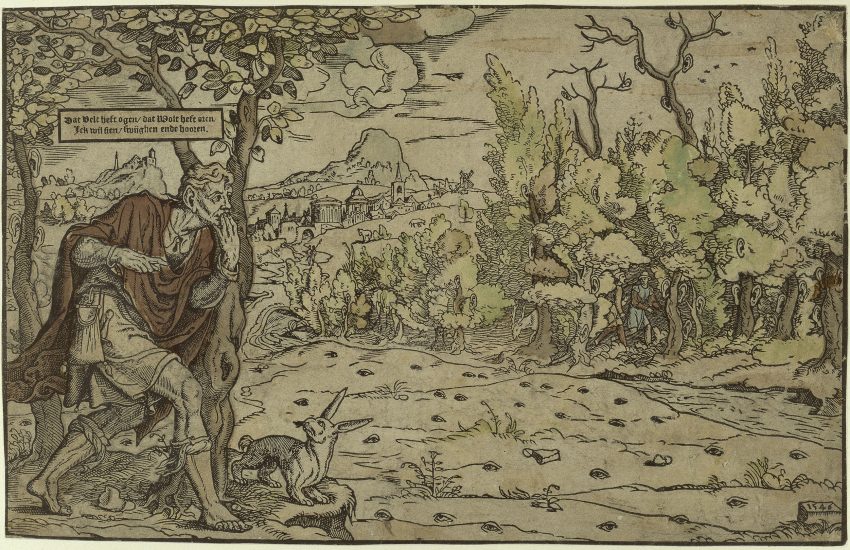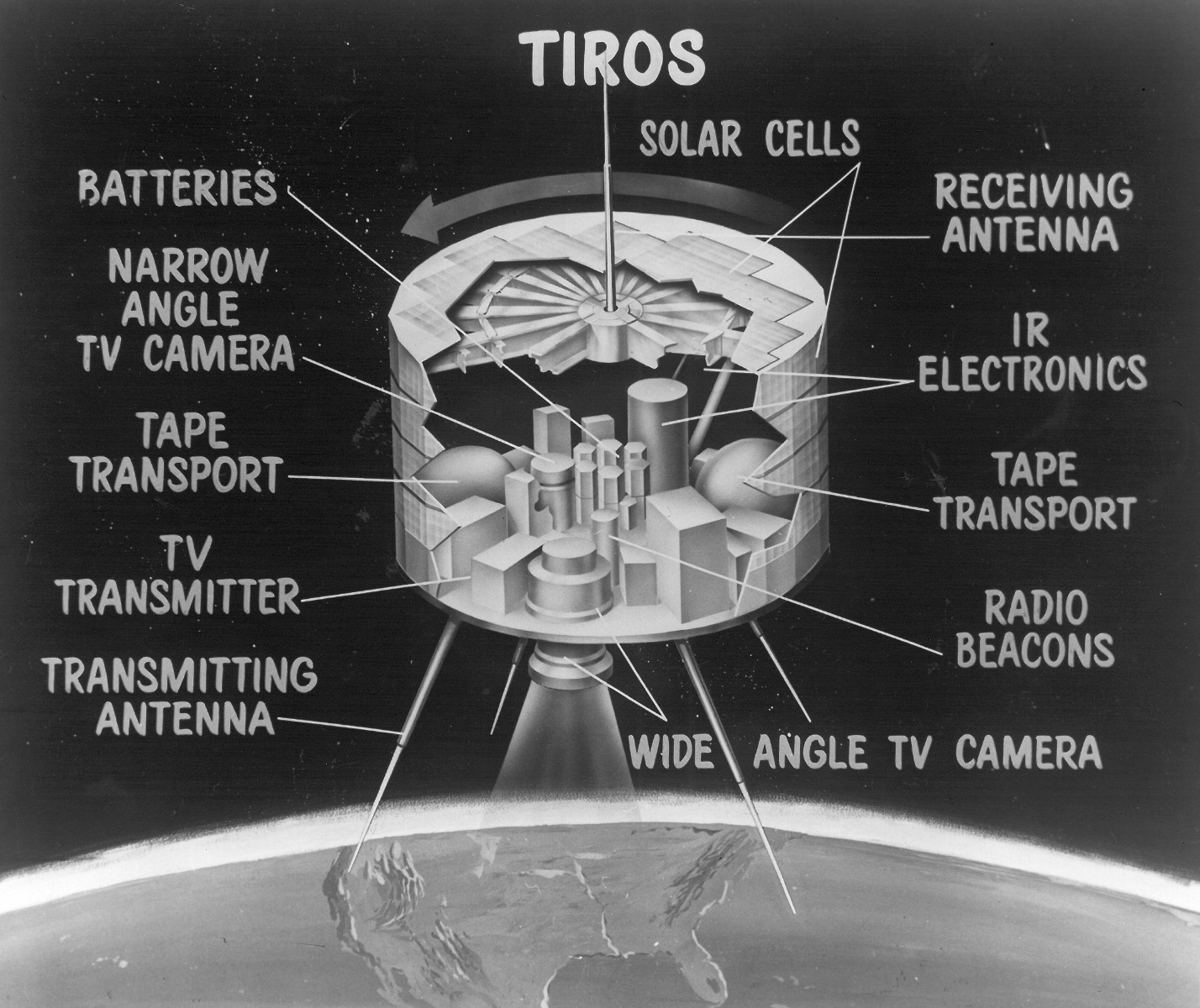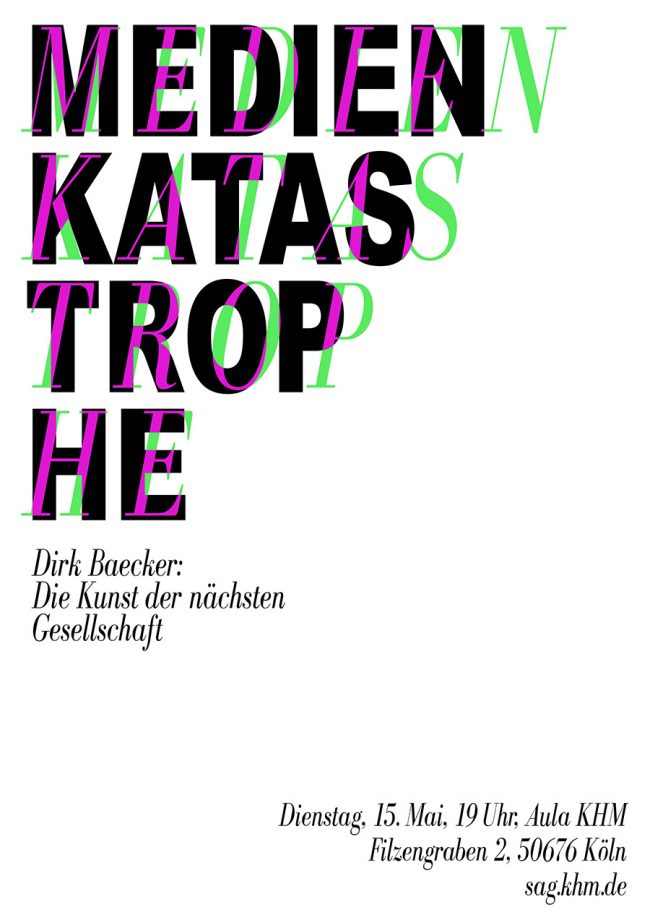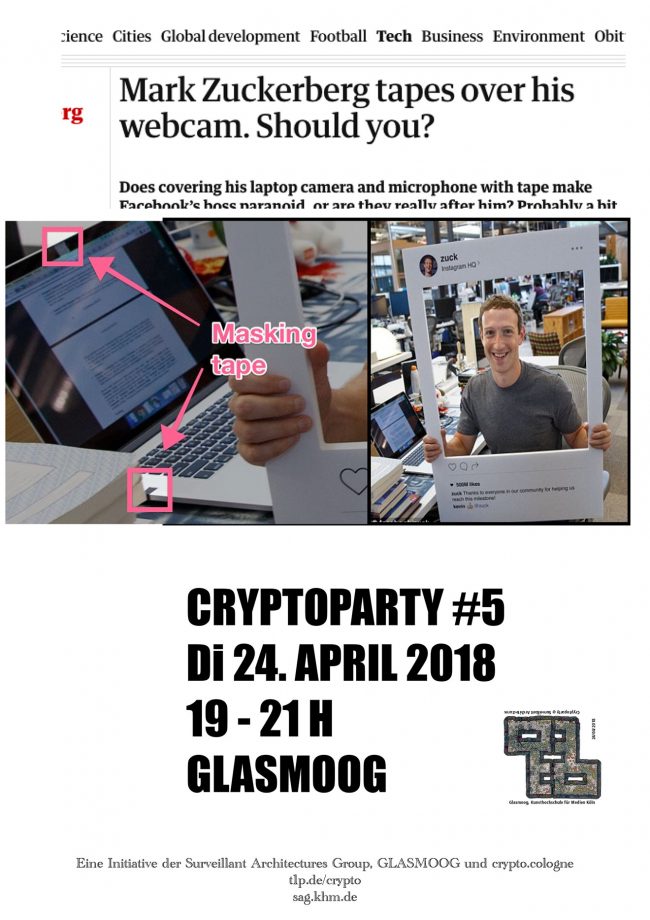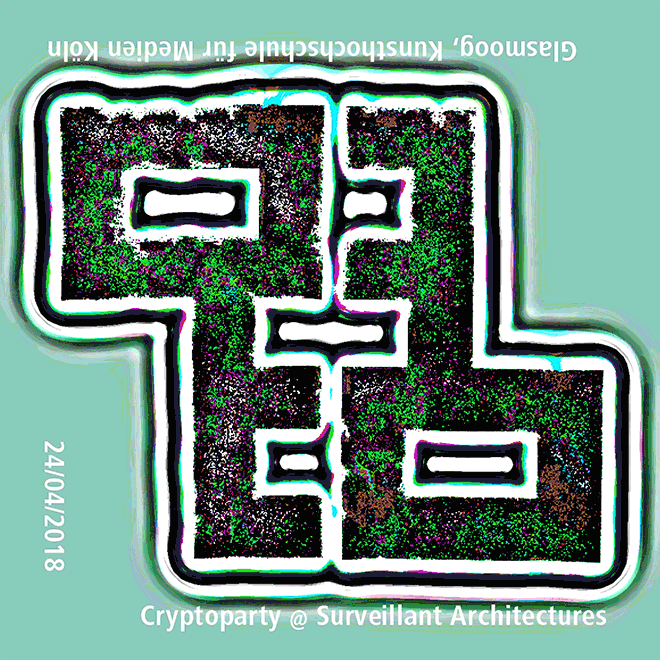A historical overview of landmark events and developments in systematised watching, throughout art and architecture, society and technology.
~60 AD (Roman Period). Early manifestations of panoptic labor camps in the Negev desert. An even older but similar site nearby dates from Early Bronze Age II–III periods (3000–2400 BC).
1546 The Fields Have Eyes, The Woods Have Ears
Unbekannter Stecher (Niederländisch): Das Feld hat Augen, der Wald hat Ohren, Holzschnitt, koloriert. © Kupferstichkabinett, Staatliche Museen zu Berlin. Foto: Jörg Anders
1608 The earliest known working telescopes appear, credited to Hans Lippershey and Zacharias Janssen, spectacle-makers in Middelburg, and Jacob Metius.
1609 Galileo uses a refracting telescope as an instrument to observe stars, planets or moons. The name telescope is coined for Galileo’s instrument by a mathematician, Giovanni Demisiani, in 1611. The name derives from the Greek tele = ‘far’ and skopein = ‘to look or see’.
mid-16oos Systematic surveillance is being implemented for the first time when three conditions come together:
a) Enough people know how to read and write and there is actually something to systematically surveil: a great international culture of letter writing that had sprung up in recent decades becomes the data to be gathered.
b) It is possible to open and re-seal letters without being noticed.
c) There is a motive: the beheading of King Charles I of England in 1649 is a huge shock to those in power. Suddenly all the other big European nations see the need to better control their populace. The first to implement this is France which decrees that from now on all letters had to go through Paris, so they could be intercepted, opened and copied in the infamous cabinet noir, the first such black room.
1673 In his book ‘Phonurgia Nova’, Athanasius Kircher proposes a system of amplifying horns and camera obscura projections by which a monarch can surveil the noblemen at his court and thereby strengthen his rule. 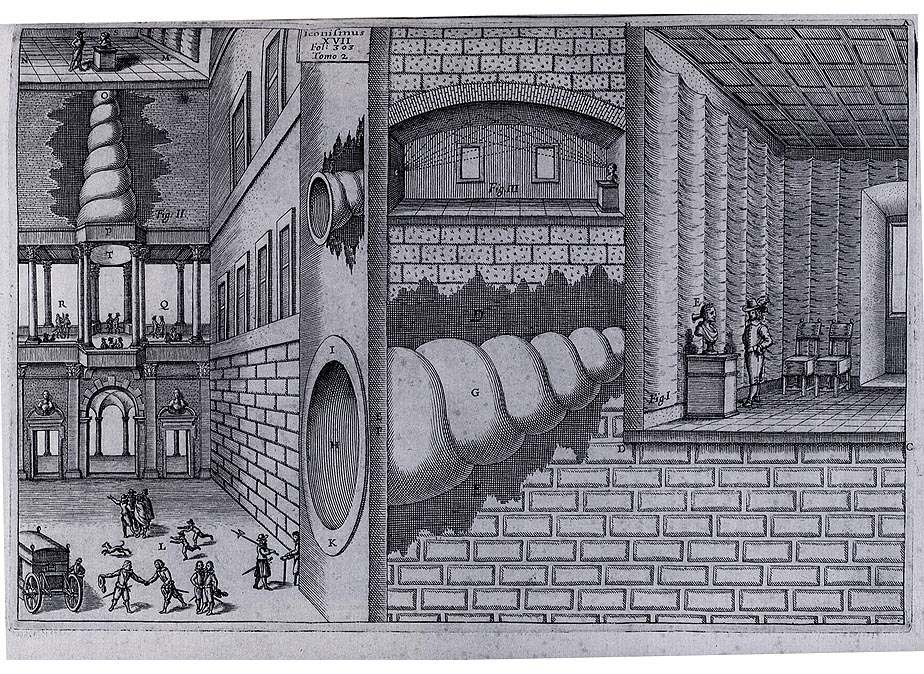
1785 Plan for Hotel-Dieu, drawing by Bernard Poyet
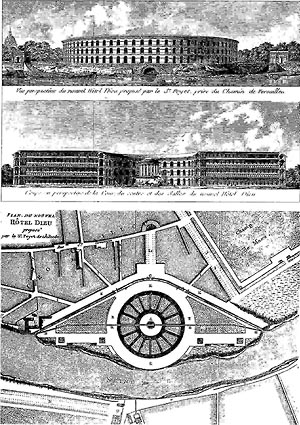
1791 General Idea of a Penitentiary Panopticon, drawing by Willey Reveley after Jeremy Bentham (the godfather of the panopticon still watches today as his auto-icon.)
![]()
A model of the Panopticon, Museum für Kommunikation, Frankfurt, 2013![]()
1840 Projet de pénitencier, Drawing by Harou Romain
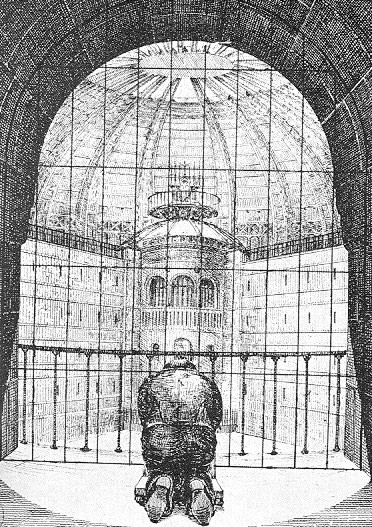
1862 Balloons are used for aerial reconnaissance in the US civil war
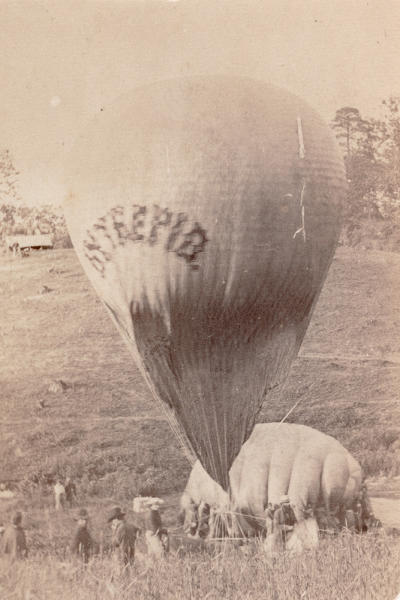
1877 Thomas Edison invents the Phonograph cylinder, a device to record sound.
1889 Herman Hollerith develops and patents a punched card data processing technology for 1890 US Census and establishes the Tabulating Machine Company, one of the three companies that later merged to form the Computing Tabulating Recording Corporation, subsequently renamed IBM.
1911 George E. Kelly recognizes military potential of aerial photography.
1914-1918 Pigeons equipped with camera for aerial survey during WWI
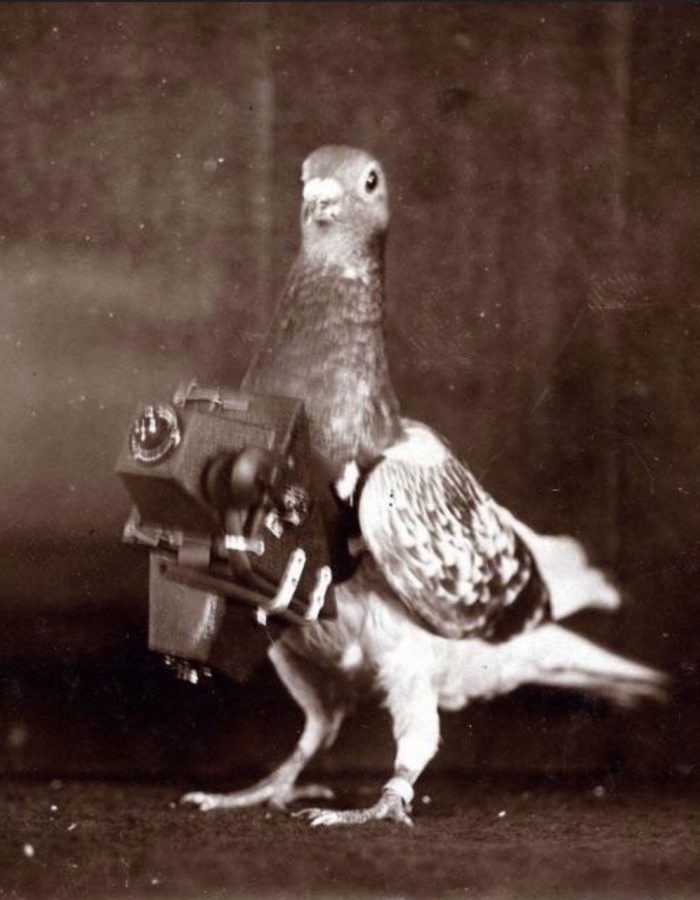
1914-1918 Before the invention of radar, aircraft were detected by listening. Directional Sound Finders used in World War I
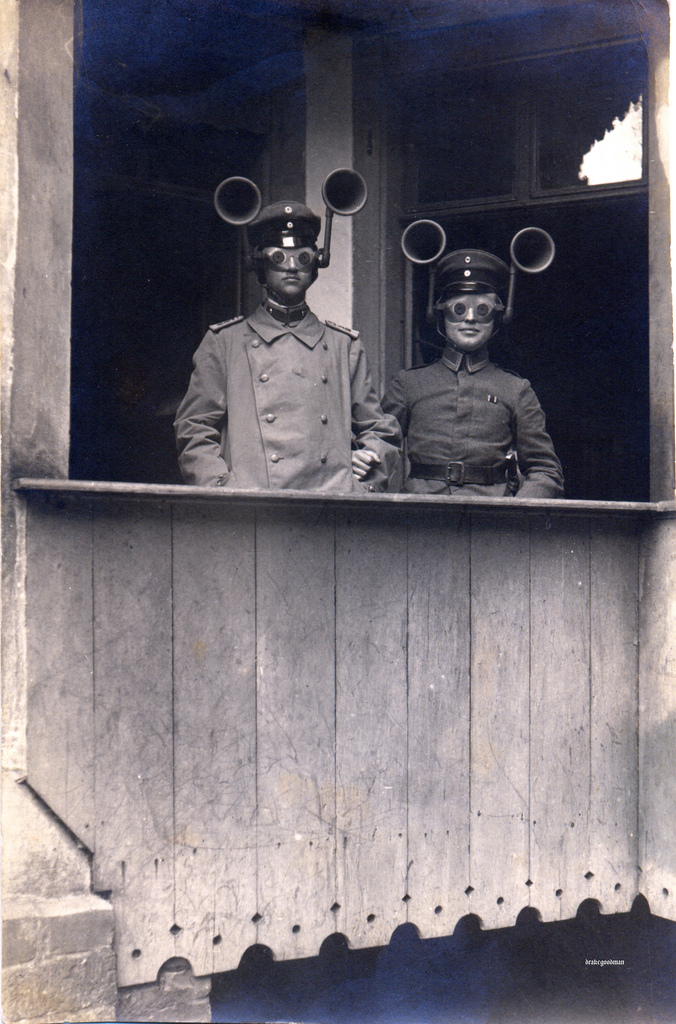
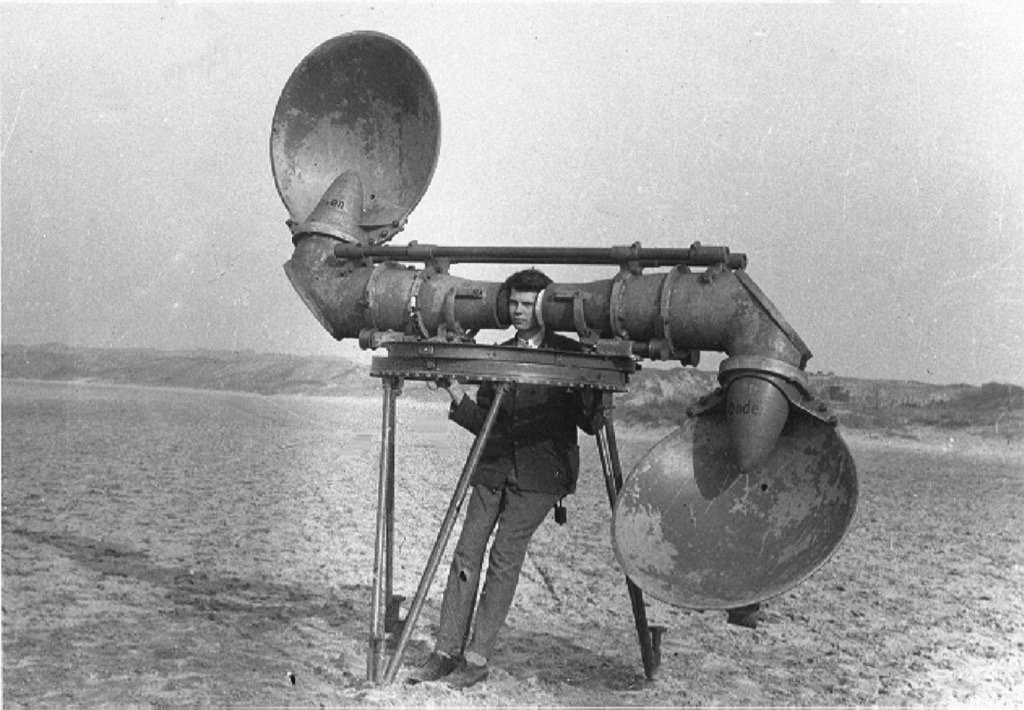
1927 Julian Huxley, brother of novelist Aldous Huxley, invents an anti-mind-control foil deflector beanie – a tinfoil hat – in his short story The Tissue-Culture King.
1927 Russian inventor Léon Theremin develops a mirror drum-based television system which uses interlacing to achieve an image resolution of 100 lines.
1927 Herbert E. Ives of Bell Labs transmits moving images from a 50-aperture disk producing 16 frames per minute over a cable from Washington, DC to New York City. Ives uses viewing screens as large as 24 by 30 inches.
1929 Dziga Vertov: Man with a Movie Camera
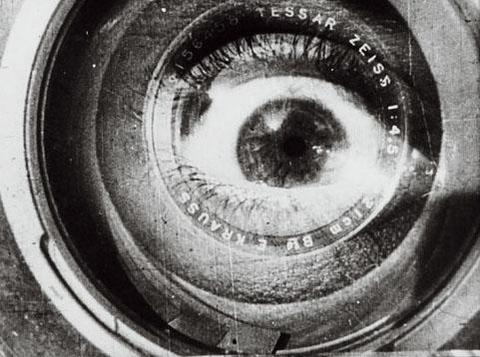
1932 Aldous Huxley: Brave New World
1930s onwards: Science Fiction authors imagine future surveillance technologies. Many of them a reality now.
1935-1944 On air period of the German TV Station Paul Nipkow. Its headquarters were in Berlin. It was named after the inventor of the Nipkow disk.
1936 Walter Benjamin: The Work of Art in the Age of Mechanical Reproduction
1939 John Cage: Imaginary Landscape No. 1
1941 Konrad Zuse developes Z3, the first working machine featuring binary arithmetic, including floating point arithmetic and a measure of programmability. In 1998 the Z3 was proved to be Turing complete, therefore being the world’s first operational computer.
1942 Siemens installs first CCTV for the monitoring the launch of V2 rockets
1945 Vannevar Bush publishes the article As We May Think in The Atlantic Monthly Journal. He is proposing a system called Memex (for Memory Extender) as an electronic extention of human memory and knowledge. A prototype both of PC and hypertext.
1946 Life Magazine photographer Yalo Joel uses a one-way mirror to trick people into posing for him
1946 Peter Goldmark (CBS) demonstrates his color television system. His system produces color pictures by having a red-blue-green wheel spin in front of a cathode ray tube.
1948 George Orwell: 1984
1949 This mechanical means of producing a color picture (by Peter Goldmark) is used to broadcast medical procedures from Pennsylvania and Atlantic City hospitals. In Atlantic City, viewers can come to the convention center to see broadcasts of operations. Reports from the time note that the realism of seeing surgery in color caused more than a few viewers to faint.
1951 The first video tape recorder (VTR) captures live images from television cameras by converting the information into electrical impulses and saving the information onto magnetic tape
1952 US President Truman formally establishes the NSA, which plays an instrumental part in the rise of the computer age. (Here’s a 1986 article by Friedrich Kittler about this, in German)
1956 Ampex sells the first VTR for $50,000
1957 Sputnik launch, 1st artificial satellite
1958 First use of stationary cameras to monitor traffic flow in Munich
1958-1980 Development and activity of SAGE, Semi-Automatic Ground Environment. This image was taken by a U.S. Air Force Airman or employee, made during the course of the person’s official duties

1960 TIROS-1, the first meteorological observation satellite launched by the USA
1962 The Mansfield, Ohio, Police Department hides a cameraman in a public restroom to gather evidence of homosexual activity. The footage was made into an artwork by William E. Jones in 2006.
1963 Philips presents first audio cassette recorder
1963 Nam June Paik exhibits 13 TV monitors at Exposition of Music – Electronic Television, Galerie Parnass, Wuppertal.
1963-65 Ted Nelson (Project Xanadu) coins the term hypertext
1964 Marshall McLuhan publishes Understanding Media
1965 Andy Warhol gets to use one of the very first Norelco video tape recorders
1966 Psychedelics are huge. CCTV installations are part of the art at the Acid Test/ Trips Festival organized by the Merry Pranksters and USCO, including Stewart Brand: trippy dancers painted in day-glo colors watch themselves dance.
1967 Guy Debord: The Society of the Spectacle. “All that was once directly lived has become mere representation.”
late 1960s: ECHELON global surveillance system established. First revealed by British investigative journalist Duncan Campbell in 1988, it remains a “conspiracy theory” until its existence is confirmed by internal NSA documents leaked by Edward Snowden in 2015.
1969 Live transmission of the first steps of man on the moon. The video transmission costs as much as the space mission itself.
1969 Vito Acconci: Following Piece in New York

1969 John Lennon/Yoko Ono make Film No 6. Rape. The relentless, continuous and brutal harassment of a girl by a male camera crew

1969 Bruce Nauman: First CCTV installation Video Corridor for San Francisco (Come Piece)
1969 Andy Warhol plans to broadcast a 6 hour stretch of continuous surveillance footage on the New York TV network; ‘Nothing Special’ was proposed to consist of footage of people walking by on the street at night. It never got made.
1969 US Defence and its Advanced Research Project Agency develop the ARPANET
1969 Sony introduces a prototype for the first widespread video cassette, the 3/4″ composite U-matic system. Sony later refine it to Broadcast Video U-matic or BVU.
1969-70 Bruce Nauman: Live-Taped Video Corridor
1969-70 Bruce Nauman: Video Surveillance Piece / Public Room, Private Room
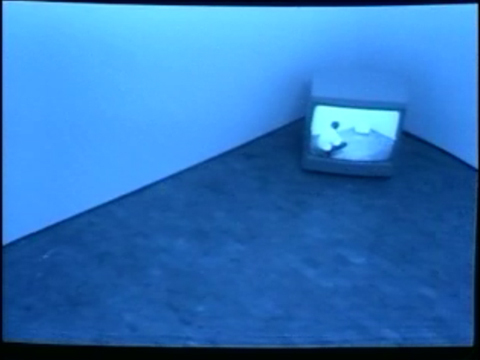
1970 William S. Burroughs publishes The Electronic Revolution (In both The Electronic Revolution and The Job (1970), Burroughs maps strategies for the use of tape recorders as instruments of psychic terrorism); (http://en.wikipedia.org/wiki/The_Electronic_Revolution)
1970 Dan Graham stages TV Camera / Monitor Performance at Nova Scotia College of Art and Design, Halifax.
1972 Jürgen Klauke starts work on Antlitze
1973 Peter Weibel: Observation of the Observation: Uncertainty
1974 The British Armyin Northern Ireland introduces first automatised vehicle number plates recognition system.
1974 Installation of 145 CCTV cameras to control traffic on major arterial roads in London. Their usage is soon expanded to include crime prevention and social control. The ongoing conflict with the IRA in Northern Ireland turns mainland UK into the most densely controlled state on earth. Today there are an estimated 4,5 million surveillance cameras in the UK, both publicly and privately run.
1974 Francis Ford Coppola: The Conversation
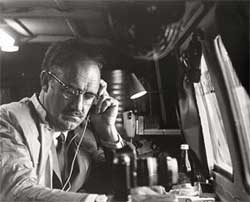
1974 Dan Graham: Time Delay Room
1975 Michel Foucault: Surveiller et punir
1976 Hannover follows the London model and installs 25 remotely controlled, movable and zoomable traffic cameras. A few years later there is blanket CCTV coverage of ‘problematic’ city areas nationwide across Germany.
1976 VHS video format introduced by JVC
1977 Dan Graham: Performer/Audience/Mirror
1978 1st GPS satellite launched
1978 Antonio Muntadas: On Subjectivity (About TV)

1978 Running Dog, a novel by Don DeLillo
“When technology reaches. a certain level, people begin to feel like criminals,” he said. “Someone is after you, the computers maybe, the machine-police. You can’t escape investigation. The facts about you and your whole existence have been collected or are being collected. Banks, insurance companies, credit organizations, tax examiners, passport offices, reporting services, police agencies, intelligence gatherers. It’s a little like what I was saying before. Devices make us pliant. If they issue a print-out saying we’re guilty, then we’re guilty. But it goes even deeper, doesn’t it? It’s the presence alone, the very fact, the superabundance of technology, that makes us feel we’re committing crimes. Just the fact that these things exist at this widespread level. The processing machines, the scanners, the sorters. That’s enough to make us feel like criminals. What enormous weight. What complex programs. And there’s no one to explain it to us.”
1979 first edition of ars electronica Festival, Linz, Austria
1980 Steve Mann begins work on wearables
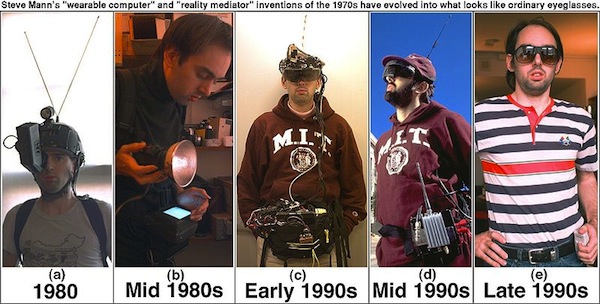
some time between 1972 and 1983: Andy Warhol‘s invisible sculpture: A temporary installation described in the memoirs of Ronnie Cutrone, a painting assistant to Warhol from 1972 to 1983. Cutrone recalls how “Andy wanted to make the Invisible Sculpture. I don’t know what the inspiration for that was. He may have watched ‘The Invisible Man’ one night on television. So … we got out the Yellow Pages and found burglar alarms, different systems. Some with sound, some with light beams….We mounted these burglar alarms on brackets all around the perimeter of the big room in the middle of the Factory…. And we aimed them all at the center of the room where nothing existed. If you walked into the room and you hit this center point, all of these alarms would go off. You’d have every different kind of sound; chirping, booming, buzzing.” h/t modernedition
1981 Sophie Calle produces The Shadow : «In April 1981, at my request, my mother went to a detetctive agency. She hired them to follow me, to report my daily activities, and to proviede photographic evidence of my existence.» In The Shadow she sets the detective’s photographic account against her own observations: the observer becomes the observed. The viewer is the third witness. This search for her own identity fails to reveal a clear picture here, too. Sophie Calle’s face does not appear in any of the pictures: her figure emerges like a shadow throughout the detective’s photographs
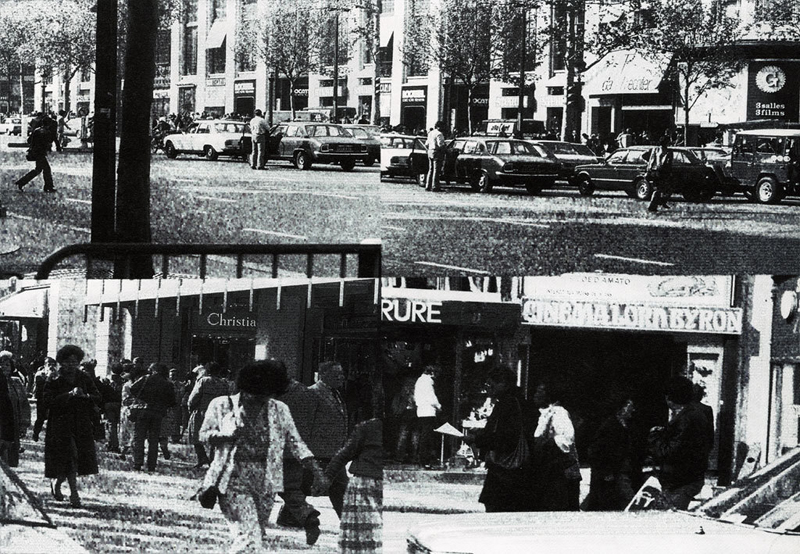
1982 David Rokeby starts to develop Very Nervous System, his first major interactive work using video cameras, image processors, computers, synthesizers and a sound system to create a space in which the movements of one’s body create sound and/or music.
1983 Michael Klier: Der Riese, an unconventionally constructed essay video on video surveillance in public space
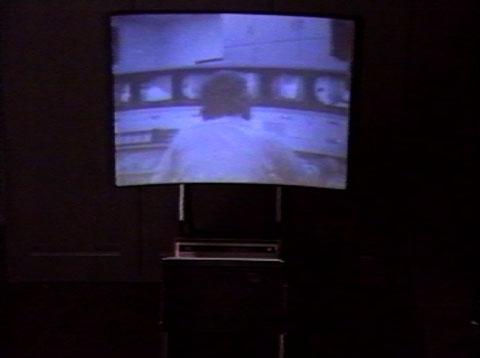
1985 Julia Scher‘s 1st reference to surveillance in Hardley Feel It Going In, a painting with a surveillance system
1986 Julia Scher‘s 1st Bubble Memory device by Hitachi Softly Tapping The Wires (interactive installation)
early 1990s London installs its Ring of Steel in response to a spate of IRA attacks. The infrastructure is still in use today and has since been upgraded and expanded several times.
1991 Julia Scher: DDD (Danger Dirty Data)
1992 Radiohead: Creep
1992 Two-year-old James Bulger is abducted, tortured and killed by two ten year old boys. The image showing the moment of the abduction makes front pages everywhere, bringing CCTV into the public imagination.
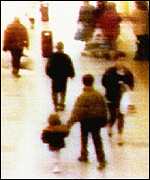
mid 1990s Privacy activists battle government officials for the right to use strong crypto in the Crypto Wars.
1995 Niels Bonde equips soft toys with cameras in I Never had Hair on my Body or Head

1998 Shizuka Yokomizo takes photos of people standing in their front rooms from the street for her ‘Dear Stranger’ project.
1998 The Surveillance Camera Players stage George Orwell’s 1984, in Art Toad’s adaptation of George Orwell’s famous anti-utopian play 1984. It takes place on the platform of a New York subway station in November 1998. http://www.medienkunstnetz.de/works/george-orwells-1984/
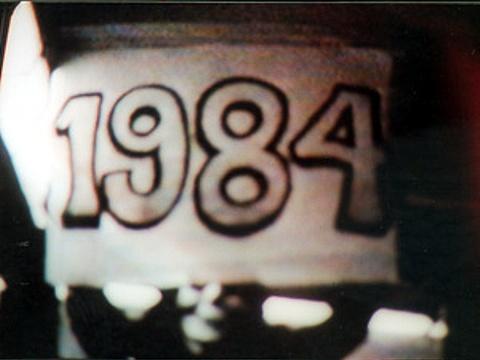
2001 CTRL [SPACE] opens at ZKM Karlsruhe. The first comprehensive overview of surveillance-related art works. The artist pages of the out-of-print and now precious catalogue can be browsed online. It’s the essays that are still worth reading, 14 years later. We have a copy in the office if you want to borrow it. the library has it, too.
2002 US Information Awareness Office established; allegedly abandoned in 2003 because of human rights and privacy concerns. 2013 Edward Snowden leaks reveal core projects were continued and up and running a few years later. One of the most ambitious / publicly known mass surveillance projects.

2003 Harun Farocki: Erkennen und verfolgen (War at a Distance). Just one of many of his works concerned with observational politics.
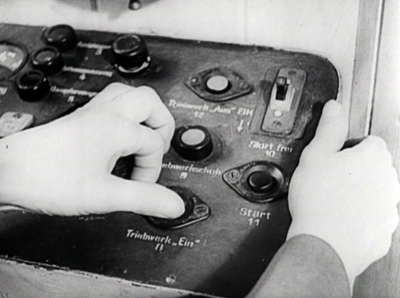
2004 Jill Magid: Evidence Locker
Multimedia Installation including Police CCTV footage, Sound piece, novella, website, email subscription system. (www.evidencelocker.net worked until 2019, now sadly defunct)

2004 Miroslav Tichý‘s work is shown for the first time, encompassing photos from the 1960’s to the present.
end 2000s New York installs its own Ring of Steel, one of the most integrated “full spectrum, military grade” surveillance networks.
2010 Exposed. Voyeurism, Surveillance and the Camera. A major exhibition at Tate Modern, London
2010 Adam Harvey: CV Dazzle: Open-Source Camouflage From Computer Vision. (“…a program of design of hairstyles and makeup to trick face detection software, to change the human face in ways that is still aesthetically pleasing to human eyes but rules out the attention of computers. This is interesting, because most of our ways of tricking computers are violently unfriendly ways.” James Bridle) See also:
2010 William Gibson proposes the Ugly T-Shirt in his novel Zero History. Using disruptive patterning, effectively what will later be called adversarial patches, to make its wearer invisible to surveillance cameras.
2010 Timo Toots: Memopol-1 An interactive installation that independently gathers and visualizes personal data. works.timo.ee/memopol/
2011 The Chaos Computer Club discovers and dissects the Staatstrojaner. Mass surveillance of Internet users makes it into the public consciousness.
2011 Wikileaks targets companies that export surveillance and control software from the West to countries that rape, torture and murder, and is used e.g. by Syria to suppress dissent.
2011 Drones find their way from the military to general police use, not just in the US but in Europe e.g. in Niedersachsen during Castor protests, to the protesters themselves, documenting their protest. The KHM’s lab3 got their first drone in 2012. The SAG gets theirs in 2016.
2012 There are an estimated 1 billion smart phones in use worldwide. They are also a perfect surveillance bug that people are happy to wear.
2012 Julian Oliver: Transparency Grenade. An open source device that automatically hacks into locally available wireless networks, sniffs traffic to extract confidential data and uploads all results to a publicly available web server.
2012 James Bridle draws Drone Shadows.
2013 Google Glass released to developers, available to the public from 2014
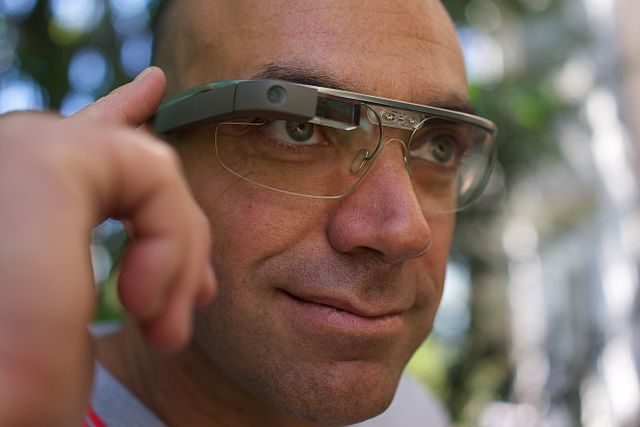
2013 The Internet of Things is looming on the horizon. In addition, our tools and gadgets are increasingly locked down, and we cannot verify what processes are running on them. In effect, we are on our way to perfect and inescapable monitoring. The movement for free and open source software and hardware is gaining ground.
2013-14 Edward Snowden leaks. It turns out mass surveillance is not a conspiracy theory, but reality. Ongoing revelations at the time of writing, including the drive for a ‘full take’ of the world’s network traffic (“Why can’t we collect all the signals all the time?”), systematic weakening of security protocols, state-sponsored hacking into friends’ and foe’s infrastructure, etc etc. Worldwide repercussions, though no large scale outcry. Security researcher Bruce Schneier argues that the Internet has been commandeered by the NSA. In an unprecedented move, a range of privacy-oriented shops shut down and destroy their hardware, rather than cooperating with what they see as intolerable conditions.
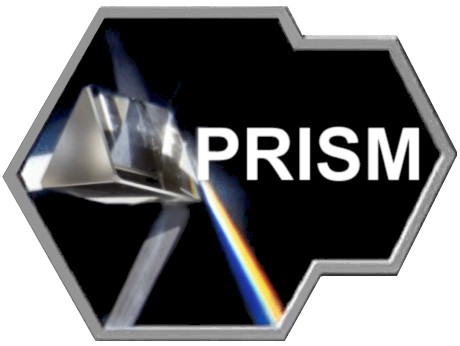
2015 Google Glass project discontinued, too much opposition to ‘Glassholes’. Apple watch goes on sale: self-surveillance doesn’t cause the same moral dilemma.
2015 my own project involving a mobile phone, posters in public space and whistleblower William Binney: Christian Sievers, Hop 3, hop3.de
2016-17 In the “West”, now, too, surveillance by state actors, corporations and peers has become something that is being accepted and endured like the weather by many people. The number of art and design projects dealing with surveillance balloons. Bernhard Serexhe and Lívia Nolasco-Rózsás curate a follow-up to CTRL [SPACE] at ZKM Karlsruhe: GLOBAL CONTROL AND CENSORSHIP (featuring teachers and students of the Surveillant Architectures seminar among many other participants). Catalogue
2016 Information warfare: new fascists (the “alt.right”) are very successfully using social media to implement regime change. Fake news, social engineering, manipulation, microtargeting and propaganda contribute to the development that culminates in Brexit and the election of Donald Trump as US president.
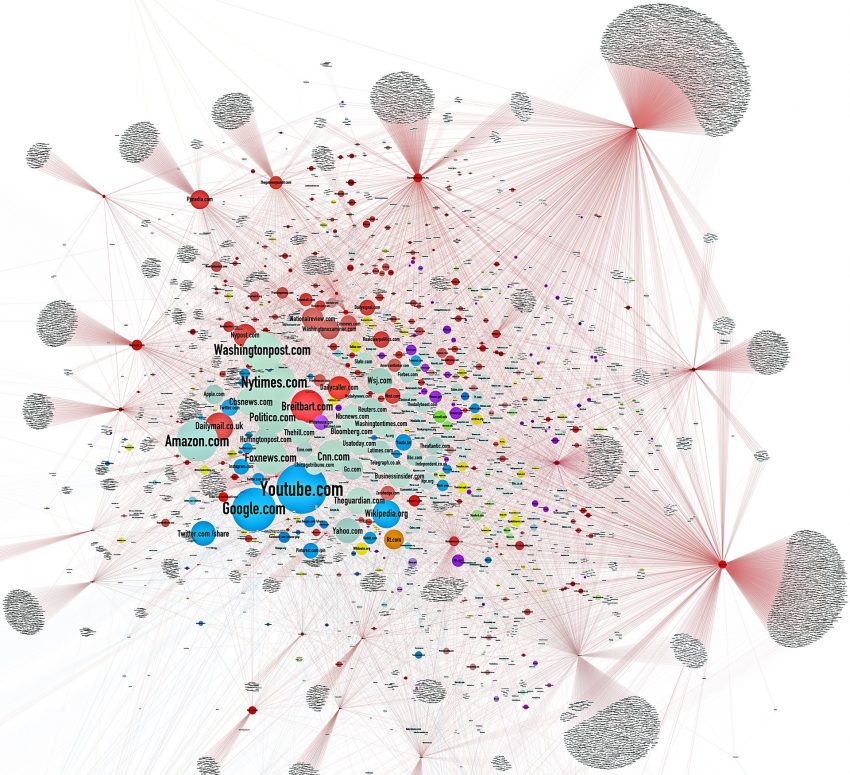
2017 Buzzwords: Machine learning (AI, neural networks) // the blockchain (Cryptocurrencies, zero-trust economy) // … (ongoing)
2017 Amazon Echo, Google Home and other voice-controlled assistants are a must-have gadget, volunarily installing devices that literally listen to everything that is being said, and send it to servers in the US for analysis. Only a few experts voice concerns about the dangers of the complete loss of privacy, falling prey to manipulation as a result of being made completely transparent, and the threat of the amassed voice data being used by criminals and state actors for blackmail and fraud.
2017 Stefani Glauber: ECHO ELIZA ALEXA
2018 High-resolution images from NASA’s 1967/8 Lunar Orbiters are released for the first time, after being withheld for 50 years to hide US spying capabilities
2018 Mark Zuckerberg’s US Senate data abuse hearing
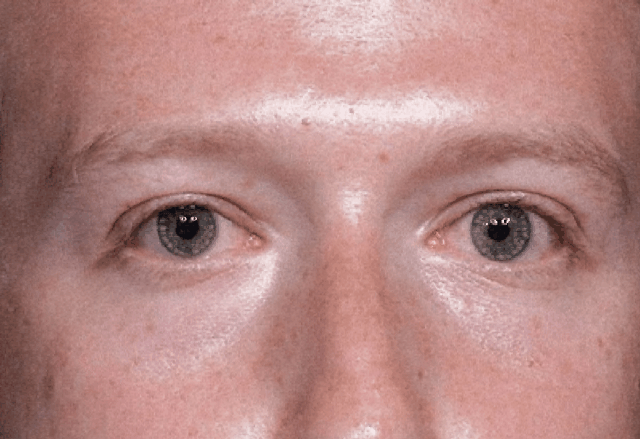
2018 Shoshana Zuboff: The Age of Surveillance Capitalism
2020 Cory Doctorow’s response: How to Destroy Surveillance Capitalism
*timeline compiled by arte-e-parte, 2008 and Christian Sievers 2011-2021
